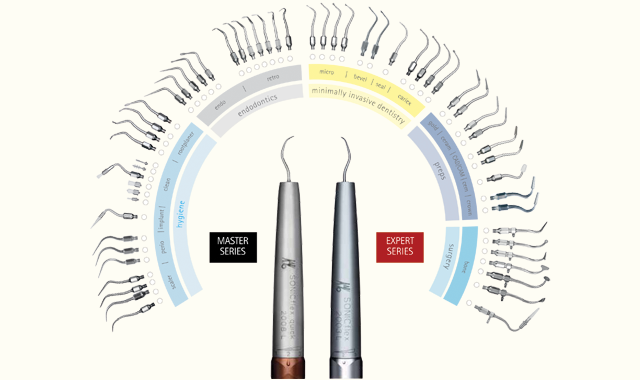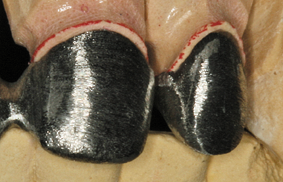I Use That: One practice's experience with KaVo Dental's SONICflex Air Scaler
In this installment of “I Use That,” we asked Dr. Arthur Volker, DDS, and his assistant, Clarissa Sing-Waller, about how they use KaVo Dental’s SONICflex Air Scaler.

In this installment of “I Use That,” we asked Dr. Arthur Volker, DDS, and his assistant, Clarissa Sing-Waller, about how they use KaVo Dental’s SONICflex Air Scaler.
Dr. Volker operates a full-service, general dental practice in Sunnyside, N.Y., performing everything from simple fillings to complex, cosmetic rehabilitations. Important to his practice are his SONICflex 2003 and 2008 air scalers, which he has used for most of his daily work for nine years.
“The SONICflex is a versatile tool and used for many jobs in the practice,” Dr. Volker said. “There are about 50 different tips so that one SONICflex is like a dentistry Swiss Army Knife.”
Trending article: New research identifies role of tiny bubbles in tooth cleaning
The SONICflex’s interchangeable tips are used for such procedures as hygiene, endodontics, minimally invasive dentistry, preps and surgery.
“I use the diamond-coated tips 90 percent of the time for restorative purposes,” Dr. Volker said. “The beauty of that is that there are many tips KaVo and Komet make so you can precisely control your margins. You can establish very smooth, clean and crisp margins. Because of the oscillating motion of the SONICflex, you will not damage the gingival tissue. It can be very slow and controlled. It can be used for the preparation of margins, removal of cavities, irrigating roots for root canals in addition to cementation and periodontal capability.”
SONICflex oscillates, rather than spinning, providing finer, more precise control and delivering exceptional results.
“This one doesn’t spin so it gives you a lot more control,” Dr. Volker said. “You can do that with a handpiece, but you run the risk of tearing gum tissue, causing bleeding, overpreparing the tooth and causing iatrogenic damage to the adjacent tooth. Plus, some of the tips are diamond-coated on one side, and because it’s not spinning, there’s sort of a smooth side. You use that on one side of the tooth so you don’t nick the tooth next to it.”
There is no lack of handpieces on the market, and Dr. Volker favors the design and functionality of the SONICflex.
“It has a very small footprint,” Dr. Volker said. “Because it does not have a magneto-restrictive field like an ultrasonic, there’s less concern for patients with certain cardiac issues, like those with pacemakers and the like. It’s an everyday tool because it has so many capabilities. There are tips you can insert to clean out the chamber of a canal. There’s the ability to cement, as well, and you can use it, obviously, as a periodontal instrument. The majority of its use would be for things like crown preparations or margin refinements, veneers, inlays, onlays and cavity preparations."
Trending article: How to help your dental practice compete now and in the future
As a bonus, the SONICflex affords such precise, exact results that it allows work to be easily scanned for labs’ CAD/CAM efforts.
“If somebody’s using a CEREC or a Planmeca (CAD/CAM system), when you get a very crisp, clean margin, it’s very easy for the computers to pick up because it’s so clean and crisp,” Dr. Volker said. “It really gives you a very precise way of doing things.”
Continue to page two to see what Dr. Volker's assistant had to say about SONICflex...
The assistant’s thoughts

Like Dr. Volker, Sing-Waller uses the SONICflex for many different functions in the practice and favors its design, ease of use and overall comfort.
“I love it,” Sing-Waller said. “I feel like it’s a lot easier to get deep down instead of using a regular composite gun. I like that the material is a lot softer. It’s a great tool for dentistry. I prefer to use it than the regular composite guns, in all honesty.
Trending article: How KaVo handpieces allow one clinician to enjoy dentistry more
“I really enjoy using it, as the assistant. It’s a lot easier for the doctor, and the procedures go by a bit quicker.”
Additionally, using the SONICflex has changed the way Dr. Volker works for the better.
“The precision on that is key,” Dr. Volker said. “It’s a very versatile tool with a lot of different inserts that are not available with an ultrasonic unit. It has, actually, a lot more functionality so for the buck, you get a lot of bang if you buy the different inserts."
Trending article: 6 common trends that flush a dental practice's profits down the toilet
ACTIVA BioACTIVE Bulk Flow Marks Pulpdent’s First Major Product Release in 4 Years
December 12th 2024Next-generation bulk-fill dental restorative raises the standard of care for bulk-fill procedures by providing natural remineralization support, while also overcoming current bulk-fill limitations.